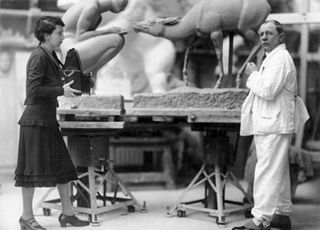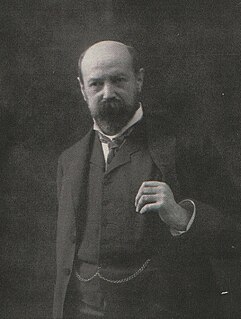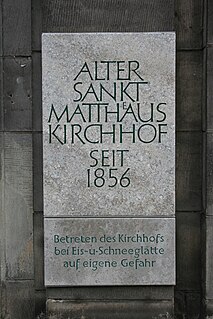
This page shows a partial list of cemeteries in Berlin .

This page shows a partial list of cemeteries in Berlin .

Mitte is the first and most central borough of Berlin. The borough consists of six sub-entities: Mitte proper, Gesundbrunnen, Hansaviertel, Moabit, Tiergarten and Wedding.

Schöneberg is a locality of Berlin, Germany. Until Berlin's 2001 administrative reform it was a separate borough including the locality of Friedenau. Together with the former borough of Tempelhof it is now part of the new borough of Tempelhof-Schöneberg.

Friedenau is a locality (Ortsteil) within the borough (Bezirk) of Tempelhof-Schöneberg in Berlin, Germany. Relatively small by area, its population density is the highest in the city.

Professor Hugo Lederer was an Austro-Hungarian-born German sculptor.
The Greater Berlin Act, officially Law Regarding the Creation of the New Municipality of Berlin, was a law passed by the Weimar government in 1920, which greatly expanded the size of the German capital of Berlin.

The New Church, is located in Berlin on the Gendarmenmarkt across from French Church of Friedrichstadt. Its parish comprised the northern part of the then new quarter of Friedrichstadt, which until then belonged to the parish of the congregations of Jerusalem's Church. The Lutheran and Calvinist congregants used German as their native language, as opposed to the French-speaking Calvinist congregation of the adjacent French Church of Friedrichstadt. The congregants' native language combined with the domed tower earned the church its colloquial name Deutscher Dom. While the church physically resembles a cathedral, it is not a cathedral in the formal sense of the word, as it was never the seat of a bishop.

Friedrich August Stüler was an influential Prussian architect and builder. His masterpiece is the Neues Museum in Berlin, as well as the dome of the triumphal arch of the main portal of the Berliner Stadtschloss.

The Waldfriedhof Dahlem is a cemetery in Berlin, in the district of Steglitz-Zehlendorf on the edge of the Grunewald forest at Hüttenweg 47. Densely planted with conifers and designed between 1931 and 1933 after the plans of Albert Brodersen, it is one of Berlin's more recent cemeteries. Its graves include those of writers such as Gottfried Benn, composers such as Wolfgang Werner Eisbrenner and entertainers like Harald Juhnke, and put it among the so-called "Prominentenfriedhöfe" or celebrity cemeteries.

Jerusalem Church is one of the churches of the Evangelical Congregation in the Friedrichstadt, a member of the Protestant umbrella organisation Evangelical Church of Berlin-Brandenburg-Silesian Upper Lusatia. The present church building is located in Berlin, borough Friedrichshain-Kreuzberg, in the quarter of Friedrichstadt. Jerusalem Church is fourth in rank of the oldest oratories in the town proper.

The Dorotheenstadt Cemetery, officially the Cemetery of the Dorotheenstadt and Friedrichswerder Parishes, is a landmarked Protestant burial ground located in the Berlin district of Mitte which dates to the late 18th century. The entrance to the 1.7-hectare (4.2-acre) plot is at 126 Chaussee Straße. It is also directly adjacent to the French cemetery, established in 1780, and is sometimes confused with it.

Alfred Messel was one of the most well-known German architect at the turning point to the 20th century, creating a new style for buildings which bridged the transition from historicism to modernism. Messel was able to combine the structure, decoration, and function of his buildings, which ranged from department stores, museums, office buildings, mansions, and social housing to soup kitchens, into a coherent, harmonious whole. As an urban architect striving for excellence he was in many respects ahead of his time. His most well known works, the Wertheim department stores and the Pergamon Museum in Berlin, reflect a new concept of self-confident metropolitan architecture. His architectural drawings and construction plans are preserved at the Architecture Museum of the Technical University of Berlin.

Trinity Church (Dreifaltigkeitskirche) was a Baroque Protestant church in Berlin, eastern Germany, dedicated to the Holy Trinity. It was opened in August 1739 and destroyed in November 1943, with its rubble removed in 1947.

The Berlin-Tegel Russian Orthodox Cemetery is the only Russian Orthodox burial ground in Berlin. It is located on Witte street in the Tegel locality of the Reinickendorf borough. It is owned and operated by the Brotherhood of St. Prince Vladimir (Bratstvo).

Paul Louis Adolf Mebes was a German architect, architectural theorist and university professor.

Waldfriedhof Zehlendorf is a cemetery located in Berlin's Nikolassee district. The cemetery occupies an area of 376,975 m². An additional Italian war cemetery was created there in 1953. A number of notable people of Berlin are buried at the cemetery; some have a grave of honor. In particular, all of Berlin's deceased post-war mayors are buried here.

Alter St.-Matthäus-Kirchhof is a cemetery in Schöneberg, Berlin, Germany. It was established in 1856 by the Protestant parish of St. Matthew. It is known for its interment of the Brothers Grimm, Jacob and Wilhelm Grimm, folklore tellers of "Cinderella" ("Aschenputtel"), "The Frog Prince", "Hansel and Gretel", "Rapunzel", "Rumpelstiltskin" ("Rumpelstilzchen"), and "Snow White" ("Schneewittchen"); Rudolf Virchow, variously known as "father of modern pathology", "father of modern medicine" or "father of social medicine"; and Claus von Stauffenberg, a German Army officer who almost assassinated Adolf Hitler. As for Stauffenberg, his corpse was exhumed by the SS on 22 July 1944, the day after his burial, and cremated to remove any traces of him. His tombstone, however, remains intact.

The Friedhof Wilmersdorf is a state-owned cemetery in the Berlin district of Wilmersdorf. It is an avenue district cemetery that has existed since 1885/1886 and has been expanded several times. The current size is 10.12 hectares. The occupied areas A, B, and D are a registered garden monument of the State of Berlin.